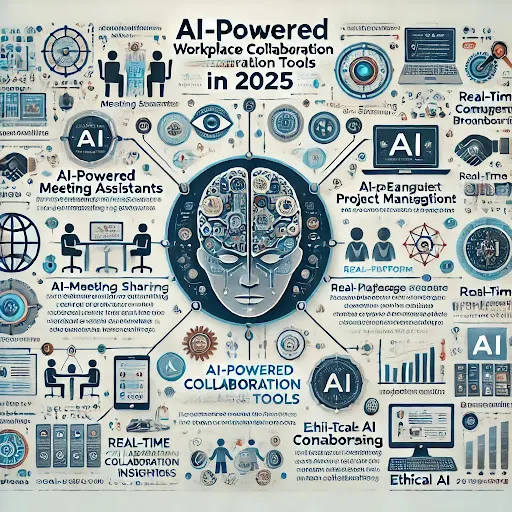AI-Powered Workplace Collaboration Tools in 2025: Transforming Teamwork and Productivity
- 공유 링크 만들기
- X
- 이메일
- 기타 앱
This post explores how AI is embedded in modern collaboration tools, transforming how teams work together, make decisions, and drive innovation.
AI-Powered Meeting Assistants
Virtual and hybrid meetings are still a cornerstone of workplace collaboration, but in 2025, AI assistants have evolved far beyond simple transcription tools. Modern AI meeting assistants automatically capture discussions, summarize key points, identify action items, and assign follow-ups to relevant team members — all in real time.
These assistants also analyze conversation dynamics, detecting when key stakeholders are quiet or when discussions are drifting off-topic, and offering gentle nudges to keep meetings on track.
Example:
A global consulting firm relies on an AI meeting assistant integrated into Microsoft Teams. After every client call, the AI automatically emails attendees a summary of decisions, action items, and unresolved questions, ensuring alignment across time zones and departments.
AI-Enhanced Project Management Platforms
AI has become a central feature in project management tools, where it tracks progress, flags potential risks, predicts task delays, and even recommends resource reallocation to avoid bottlenecks.
By analyzing historical project data, team availability, and task complexity, AI provides realistic delivery timelines and identifies potential skill gaps within project teams — enabling managers to proactively address issues before they impact deadlines.
Example:
A product development team uses an AI-augmented project management platform that predicts which product features are at risk of delay based on team bandwidth, historical work patterns, and external dependencies.
Intelligent Knowledge Sharing and Documentation
Knowledge management has always been a challenge, particularly for large organizations with distributed teams. In 2025, AI-powered collaboration tools automatically capture knowledge from meetings, project documents, and team chats, converting them into searchable knowledge bases enriched with AI-generated summaries and contextual tags.
AI also helps new team members onboard faster by personalizing their knowledge feeds, recommending relevant documents, processes, and internal experts based on their role and project assignments.
Example:
A software development firm uses an AI-powered internal wiki where every project update, decision log, and retrospective is automatically summarized and tagged, ensuring that teams always work from a single source of truth.
AI-Powered Collaboration Insights
AI doesn’t just improve processes — it also helps leaders understand how teams work together. In 2025, collaboration tools analyze communication flows, document edits, and decision-making patterns, offering insights into team dynamics, productivity bottlenecks, and even potential burnout risks.
These insights are delivered via privacy-respecting dashboards, enabling managers to support work-life balance without invasive surveillance.
Example:
An HR department receives a weekly collaboration health report, generated by their AI-enhanced communication platform, highlighting overworked teams, underutilized experts, and cross-departmental collaboration gaps.
Cross-Platform AI Integration
Workplace collaboration no longer happens in isolated tools — in 2025, AI acts as a connective layer across platforms. Whether teams work in Slack, Google Workspace, Notion, or Asana, AI ensures that action items, deadlines, and critical insights flow seamlessly between platforms, reducing the need for manual updates and status checks.
Example:
A marketing team planning a product launch uses an AI integration layer that automatically syncs creative briefs from Notion into Trello task lists, pulls deadlines from Google Calendar, and updates Slack channels when milestones are completed.
AI for Real-Time Language Translation and Cultural Nuance Detection
With global teams working across languages and cultures, AI-enhanced collaboration tools in 2025 offer real-time translation during meetings and document collaboration. Beyond basic translation, these tools detect and flag potential cultural misunderstandings, ensuring clear communication and fostering cross-cultural respect.
Example:
A multinational engineering firm uses AI-powered collaborative editing tools that provide real-time translation suggestions, while also flagging phrases that could be misinterpreted across different regional offices.
AI-Augmented Brainstorming and Ideation Sessions
Creativity isn’t limited to designers — every team benefits from collaborative ideation, and AI enhances this process in 2025. During brainstorming sessions, AI tools surface relevant market trends, customer insights, and competitor strategies in real time, enriching team discussions and providing creative prompts.
Example:
A product strategy team uses an AI brainstorming assistant that analyzes customer feedback in real time, suggesting product features aligned with evolving customer needs and competitive gaps.
Ethical and Inclusive AI Collaboration
As AI takes on a larger role in shaping collaboration, ethical considerations have become a critical component of AI deployment strategies. In 2025, companies adopt AI transparency policies, ensuring that all AI-generated recommendations, summaries, and insights are fully auditable and explainable.
AI tools are also designed to promote inclusivity by ensuring that all voices — regardless of seniority, location, or communication style — are heard in collaborative processes.
Example:
A global non-profit uses an AI-powered collaboration platform that ensures equal airtime during virtual meetings, highlighting when specific participants (like junior staff or remote employees) are consistently overlooked.
The Future of Human-AI Collaboration in Teams
In 2025, the most successful teams aren’t just adopting AI-powered collaboration tools — they’re actively developing AI literacy and embedding AI into their culture of teamwork and innovation.
AI becomes not just a tool, but a trusted collaborator that helps teams:
- Work faster and smarter.
- Avoid blind spots and biases.
- Surface the best ideas from across the organization.
- Foster inclusive, balanced, and creative work environments.
The organizations that fully embrace AI-augmented collaboration gain not only operational efficiencies, but also higher employee satisfaction, faster innovation cycles, and stronger organizational resilience.
Conclusion
The future of collaboration is here — and it’s powered by AI. By embedding AI into every stage of teamwork, from brainstorming and planning to execution and review, organizations unlock new levels of productivity, transparency, and creativity. The challenge for leaders isn’t whether to adopt AI-powered collaboration tools, but how to weave them into the culture, workflows, and values of the modern workplace.



